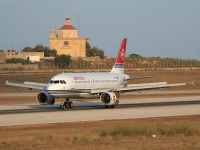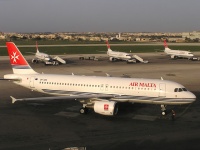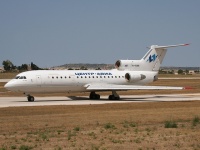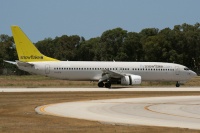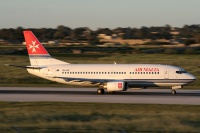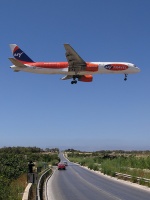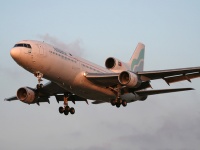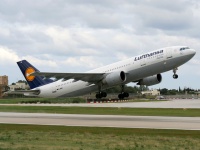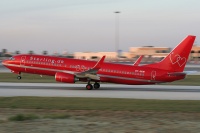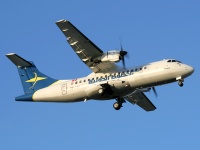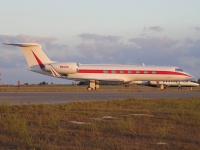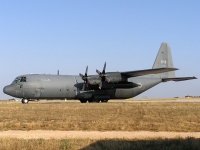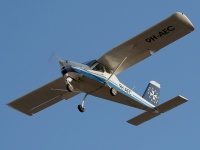Malta International Airport
| Continent: Europe | Country: Malta |
| Malta International Airport (MLA/LMML) | |
| Location | Malta |
| IATA code | MLA |
| ICAO code | LMML |
| Airport type | Mixed-Use Commercial |
| Website | http://www.maltairport.com/ |
| Overview map | [1] |
| Communications | |
| Tower | 135.100MHz |
| Ground | 121.825MHz |
| Clearance | |
| Approach | 128.150MHz (Luqa Radar) |
| Departure | As above |
| ATIS | 127.400MHz |
MLA is an airport with a proud history. As RAF Luqa, it was one of the airfields from which the epic defence of Malta was conducted in 1941-42. It was also a base for offensive operations aimed at cutting off supplies to the Axis forces in North Africa, contributing in no small way to the Allied victory in the Mediterranean.
After Malta's independence RAF Luqa was developed as a commercial airport and today it is Malta's only airport for fixed-wing aircraft. It has two runways. Runway 13/31, the longer one at 3.5 km, is normally used for commercial passenger traffic while runway 05/23 (length 2.4 km) is used mainly by light aircraft. The runways were formerly 14/32 and 06/24 but were retitled in June 2008 in keeping with the gradual shift of the earth's magnetic field.
The volume of traffic at MLA is obviously limited by comparison to major airports in large countries. Photographers who are planning a trip to Malta should consult the flight schedules in the airport's official website, which are available two weeks in advance, to ensure that their visit to the airport coincides with the active periods during the day.
That said, MLA still offers the spotter a variety of aircraft types and liveries. It is also a very spotter-friendly airport, both in terms of the availability of good vantage-points for photography and in the sense that photography is officially tolerated.
Official Spotting Locations
Terminal Viewing Gallery
Offers an excellent view of park 9 (the main apron for passenger aircraft) but is behind glass and reflections are an obstacle. Moreover, much of the space available has been taken up by a children's play area that was installed in summer 2006 and opening hours have been restricted. However there is no other vantage-point suitable for photography within the airport, even airside, unless you have ramp access.
Time of day: Morning only as most aircraft on the ramp will be backlit in the afternoon. Nightshots are possible, but only for aircraft parked facing the terminal on the central parking bays.
Directions: The viewing gallery is located on the 3rd floor of the tower between the arrival and departure halls. If arriving by car, you can park in the airport car park. Alternatively you can take a bus to the terminal, and additional routes serve a bus stop on the way to Zurrieq just past the airport McDonald's restaurant. For route numbers see the section on facilities and transportation below.
A note about sample photos: indicative focal lengths refer to 35mm format and you need to apply the crop factor appropriate to your camera, e.g. divide by 1.6 for a Canon 350D/20D/30D or by 1.5 for a Nikon D50/D70/D200.
- JetPhotos.net sample photo: large (MD-83 on ramp at night - 50mm)
Other Spotting Locations
Airport Perimeter Near Taxiway C
This spot is an excellent morning vantage-point for departing aircraft on their way to runway 31 or arrivals exiting runway 13 via taxiways C or D. Aircraft in the nearer parking bays in park 9 are also reachable. Runway 31 takeoffs can be photographed with a moderately long lens. There are cutouts for photographers at intervals in the fence so a stepladder is not necessary, though shooting takeoffs through the cutouts is difficult.
However, heat distortion can be a problem on hot days when shooting at any distance and to avoid it you may find yourself limited to shooting aircraft on taxiway C.
Time of day: Morning only (not later than around 9 am in winter).
Directions: Leave the terminal building and cross the carpark to get to the main road. Turn right and follow the road as it curves to the right. As soon as you are past the VIP entry gate and crash gate 3 you can pick your spot.
If you’re travelling by car, head for the airport but when you reach the Gudja/airport/Luqa roundabout take the road to Hal Far (it runs parallel to the airport access road but does not descend). Watch for the above-mentioned VIP and crash gates. Parking is possible to one side of the crash gate and across the road. Just be very careful when crossing the road!
Chapel of Our Lady of Loreto
An elevated vantage-point for runway 31 landings and for take-offs in either direction. However, for runway 31 movements it is only just high enough to clear the airport perimeter fence and the street lights present an additional obstacle. If you have a step-ladder you would be better off shooting runway 31 take-offs and landings from next to the perimeter fence.
Time of day: Morning only (up to around 9 am in winter).
Directions: As with the previous spot, but keep following the road till you see a steep dirt track on the opposite side of the road which provides access to the chapel. Cross with care. The track is accessible by car, but be careful when re-entering the main road.
Runway 31 Threshold
This is an excellent location for photos of aircraft approaching runway 31 if you're content with in-the-sky shots (no terrain visible). There is a wide roadside walkway, though you have to cross to the other side of the road to get photos to avoid the streetlights. The road is beneath the level of the runway at this point so through-the-fence touchdown photos are not possible.
Time of day: You can shoot from either side of the flight path so this spot is good for the whole day, although photos will not turn out so well when the sun is at its highest. On hot days avoid shooting at long range (above say 200mm) because heat distortion will affect the photos in spite of the aircraft still being well above ground.
Directions: As with the previous spot but keep following the perimeter road until it bends right at the end of the runway. The walk from the terminal should take 20-30 minutes - though this is a non-walker's estimate! If driving, parking is possible at some gaps in the crash barriers on either side of the road.
Perimeter Fence off Road to Safi
Good for runway 31 touchdowns, although an old farmhouse on the right will restrict your view of incoming aircraft. Large building blocks have been deposited at this site, apparently as a prelude to future works, but so far it remains accessible.
Time of day: Afternoon and evening (from about 9 am onward in winter).
Directions: As with the previous spot but follow the road up the hill. Near the top turn right to take an old country road leading to the village of Safi. Very soon you will come to a fork in the road. Keep right and you will soon reach the airport perimeter fence. This spot will add some 15 minutes to your journey from the terminal if you are on foot.
- JetPhotos.net sample photo: large (Tu-154 touching down - 210mm)
The Spotters' Wall (Safi side)
The Spotters' Wall, as it is known, is really an elevated viewing platform. Built by the Malta Aviation Society some years ago, it offers unobstructed views of runway 13/31 and it is the place from which to shoot takeoffs in either direction. With any luck the aircraft will rotate right in front of you. It is easily the best spot for photography at MLA. Its only drawback is its very popularity: it can get crowded if there is a particularly unusual movement.
Across the road from here lies the Medavia/NCA aircraft maintenance complex. Aircraft cross the road to the complex and back via a gate in the airport perimeter just beyond the viewing platform, with road traffic being temporarily halted by barriers. Aircraft crossings are infrequent, however, and you would need to be very lucky to witness one.
Time of day: Noon to evening or from around 9 am on in winter for take-offs and landings.
Directions: Starting from the airport terminal, go left as you leave the building and head for the airport McDonald’s restaurant. Pass it by and you will reach the road to Zurrieq. Turn left and follow the road through a tunnel (there is a roadside pavement for walkers). As you emerge from the other side of the tunnel you will reach a roundabout: go left again and carry on till you reach the viewing platform. The walk should take perhaps 20 minutes.
If arriving by bus, there is a bus stop just past the end of the tunnel which is served by all the buses mentioned below under facilities and transportation, except the airport bus proper. Get off here then follow the above directions.
If driving, head for the airport but take the road to Zurrieq at the Gudja/airport/Luqa roundabout. Parking is available next to the viewing platform and across the road.
- JetPhotos.net sample photo: large (the Spotters' Wall)
- Airliners.net sample photo: medium large (aircraft crossing the road - photo taken from the Spotters' Wall)
Runway 23 Threshold
This spot is good for aircraft approaching runway 23. Aerial traffic is usually very light and a visit is only worth it if a movement is expected or if runway 13/31 is closed for some reason.
Time of day: All day since you can shoot from either side of the flight path.
Directions: This location is not a feasible proposition for walkers. If driving, you need to make your way towards the airport until you reach the outskirts of Luqa. Ignore the signs directing you left to the airport passenger terminal and keep following the road past the Armed Forces of Malta barracks and the airport freight terminal, until you come to a roundabout with a colourful phallic sculpture (honest!) at its centre. You can park next to the shops on the opposite side of the road.
Runway 13 Threshold
This is a good spot for aircraft on approach to runway 13. Unlike runway 31 the road here is at the same level as the runway, but the runway threshold is impossibly far from the perimeter fence. From here you can also see park 3 where the occasional executive jet, light plane or small turboprop may be parked. Beware of heat distortion on hot days however.
Time of day: The runway 13 approach is viable for morning photography if you are prepared to take head-on shots from directly beneath the flight path, but this location really comes into its own in the afternoon. For aircraft in park 3 you need to wait for the late afternoon and evening.
Directions: This spot is not feasible for walkers. By car, follow the directions to the previous spot but go past the phallic sculpture. You will then descend a hill, at the bottom of which you will find another roundabout this time sporting a metal rocket-like construction. Turn left here and take a very bumpy road uphill. At the crest of the hill on your left you will come to a clearing next to the airport perimeter fence, where you can park. You will be practically under the flight path at this point but you can walk further up the road, angle of the sun permitting, to shoot side-ons.
Park 4
The occasional executive jet, civil or military transport or light plane may be parked here, though light aircraft tend to be parked far from the fence at a point where the ground dips, making them hard to photograph. There are cutouts for photography at intervals in the fence. Unless your subject is close to the fence you'll have to watch out for heat distortion and you may have to wait for the sun to start descending. Nightshots are also possible in this location.
Time of day: Late afternoons, evenings and nights.
Directions: As above, but continue on the road as it winds along the airport perimeter fence. You will pass by the huge new Lufthansa Technik maintenance facility which is being built inside the airport grounds, following which the road rises briefly and levels out again. At this point you have reached park 4.
- JetPhotos.net sample photo: large (Il-76 nightshot - 110mm)
Runway 05 Threshold
Good for approaches to runway 05. As regards traffic the same applies to this spot as to the runway 23 threshold.
Time of day: Virtually all day.
Directions: Follow the road all the way past park 4. Watch for oncoming cars where the road narrows. Just past the bottleneck there is a crossroads: turn sharp left and you will come to the runway threshold very shortly thereafter. You can park by the roadside for a while.
Locations to Avoid
Don't obstruct any roads or airport crash gates, don't cause any damage, don't trespass on private land and you should be perfectly OK. And don't make holes in the perimeter fence!
There may be some restrictions on photography near the VIP Gate should a VIP be boarding or disembarking from an aircraft. Otherwise unrestricted.
Regular Traffic
The most important operator at MLA is obviously Air Malta, which operates a fleet of Airbus A319s and A320s. Two other local airlines, BritishJet and European 2000 Airlines, have ceased operations. There are two flying schools which contribute to a fairly lively general aviation scene. Also based at MLA is the Air Wing of the Armed Forces of Malta, which operates Alouette III helicopters and Bulldog light aircraft.
MLA hosts two maintenance and repair facilities. The Lufthansa Technik Malta plant, located in the airport grounds, carries out C-checks on Airbus and Boeing narrowbodies and will also undertake D-checks on Airbus widebodies as from October 2008 in a large new facility which is being built for the purpose. Next to the airport on the Safi side (across the road from the Spotters' Wall), the Medavia/NCA complex carries out maintenance work on smaller aircraft. Medavia operates its own small fleet of turboprops, mostly on ferry flights to and from North Africa.
Other airlines which fly to Malta throughout the year include British Airways, Alitalia, Lufthansa, Emirates, Ryanair, Germanwings, Sevenair, Libyan Airlines, Thomas Cook, Thomsonfly and Easyjet (ex-GB Airways).
In summer traffic increases considerably. Airlines which operate seasonal Malta routes constitute an ever-varying collection but normally include Austrian Airlines/Lauda, SAS, Sterling, Finnair, Spanair, Atlant-Soyuz and First Choice. As already mentioned, the best bet for the overseas visitor is to consult the flight schedules on the MLA website. Aircraft types used include Airbus and Boeing narrowbodies, CRJs, ERJ-145s, ATR turboprops, and Boeing 777s (Emirates). Occasional visitors, particularly in summer, can include anything from military aircraft in transit to chartered 747s.
Facilities and Transportation
There is a regular bus service (route 8) from Valletta to the airport terminal via Gudja. In addition, routes 32 and 34 (Valletta-Zurrieq) and 35 (Valletta-Qrendi) all serve bus stops within easy reach of the terminal and the Spotters' Wall, which is the best spot for photography. More information can be obtained from the Malta Transport Authority website.
